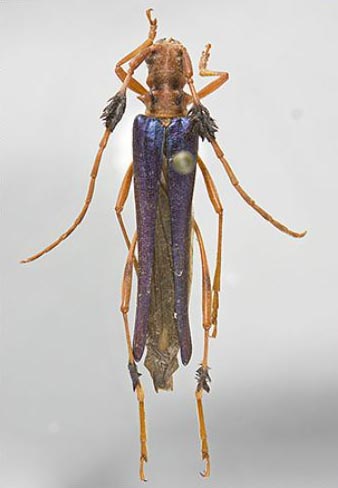 |
Necydalini
Classification
Introduction
- The subfamily Necydalini Latreille, 1825 currently contains ~100 species in 12 genera. Photographs of 5 exemplar specimens are currently available for this tribe.
Diagnostic Features of Adults
- Mandibles slender, acute, with a pubescent fringe along inner margin; elytra abbreviated, scarely extending over base of abdomen; wings not folded; stridulatory plate of mesonotum entire; mentum transverse (Linsley & Chemsak, 1972).
- Mesoscutum with undivided stridulatory file. Mesotarsus with 4 distinct tarsomeres and reduced penultimate one (pseudotetramerous). Ratio of elytral length to pronotal length 1.03-1.5. Mesoventrite with paired procoxal rests (Lawrence, 2007).
Diagnostic Features of Larvae
- Larva. Head subcordate, strongly tapering in front, widest behind middle, having, in some species, the dorsal margin of epicranium behind front slightly fused, suggesting Aseminae; antennae fleshy, situated rather more dorsally than in other Lepturinae, and less retractile, basal membrane incapable of retraction into large antennal fovea, third joint minute; labrum usually transverse; ventral mouth-parts very fleshy and, though widely articulated at base to anterior edge of hypostoma, not filling entire width; lacinia large and usually broader at apex though less so in Ulochaetes; ocelli absent or minute, indistinct; gular sutures protuberant. There is a tendency for these larvae to be covered with fine asperities, most marked in Ulochaetes, and the ampullae are closely beset with bead-like tubercles in all species of Necydalis. The epipleurum is very narrow. The body is soft and fleshy, slender, tapering, cylindrical. Adapted from Craighead (1923).
The larvae of this tribe show a strong and undoubted relationship to the Aseminae. This is illustrated in the tendency (in some species) of the dorsal margins of the epicranium to be slightly fused and in the short, robust, triangular mandible. In Ulochaetes it is shown by the velvety asperate pronotum and ampullae, and the two lateral impressions marking off the ambulatory ampullae, caused by the splitting of the strong muscles from the posterior cuneal notch. The legs are weaker than in other Lepturinae and jointed as in the Aseminae. Adapted from Craighead (1923).
Geographic Distribution of Tribe
Biology and Economic Importance
- Larvae of most species develop for about one year in the trunk or branches of dead trees (or dead portions of leaving trees). Some species can have two broods per year. Adults are relatively short lived, probably most living less than 1 month. Most feed conspicuously on flowers as adults and thus are important pollinators (summarized from Linsley, 1961; Lawrence, 2007, and other sources).
Adults mimic both morphologically and behaviourally certain hymenopterans; Necydalis apparently larger wasps, Ulochaetes resembles bumblebees. Some species of Necydalis may visit flowers, but generally the subfamily is not typically floricolous or pollinophagous (Svacha & Lawrence, in review).
Selected References to Adult Specimens
Selected References to Larvae Specimens
|  |

Atelopteryx compsoceroides
Lacordaire, 1869; dorsal
Cerambycidae:Necydalinae:Necydalini
Photograph © N.P. Lord

Atelopteryx compsoceroides
Lacordaire, 1869; head
Cerambycidae:Necydalinae:Necydalini
Photograph © N.P. Lord

Atelopteryx compsoceroides
Lacordaire, 1869; lateral
Cerambycidae:Necydalinae:Necydalini
Photograph © N.P. Lord
All Necydalini exemplar species images
|




